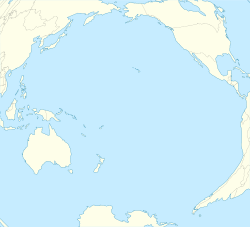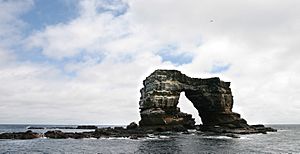Darwin's Arch facts for kids

Darwin's Arch, 2006
|
|
|
Location in the Galápagos Islands##Location in the Pacific Ocean
|
|
| Geography | |
|---|---|
| Location | Southeast of Darwin Island, Galápagos Islands, Ecuador |
| Coordinates | 1°40′19.2″N 91°59′26.6″W / 1.672000°N 91.990722°W |
| Archipelago | Galápagos Islands |
| Administration | |
Darwin's Arch (which means Arco de Darwin in Spanish) was a famous natural rock arch. It was located southeast of Darwin Island in the Galápagos Archipelago. This group of islands is in the Pacific Ocean.
The arch sat on a rocky area underwater, which divers called "the theatre." On May 17, 2021, the arch collapsed. This happened because of natural erosion and gravity. Now, instead of an arch, there are two tall rock towers left.
Both Darwin's Arch and the nearby Darwin Island were named after Charles Darwin. He was an English naturalist. His studies in this area helped him create his famous theory of evolution by natural selection. To honor Darwin and his work, the remaining rock towers are now known as "the Pillars of Evolution."
Contents
Where Was Darwin's Arch?
Darwin's Arch was part of Ecuador's Galápagos archipelago. It was about 1 kilometer (0.6 miles) southeast of Darwin Island. Darwin Island is a small island that no one lives on. It covers about 2.33 square kilometers (0.9 square miles).
The arch looked like a natural bridge. It was formed over many years by the ocean wearing away the rock. The arch was about 43 meters (141 feet) high. It was 70 meters (230 feet) long and 23 meters (75 feet) wide.
Amazing Ocean Life
The waters around Darwin's Arch were full of incredible marine animals. It was a very popular spot for scuba diving. Divers could see many different types of sharks. These included scalloped hammerhead sharks and Galapagos sharks. They also saw whale sharks, which can be as long as 14 meters (45 feet). Whale sharks are often seen here starting in early July.
Other amazing creatures found here included manta rays and eagle rays. There were also green turtles and hawksbill turtles. You could also spot large groups of pelagic fish, like big-eye jacks, bonito, and yellowfin tuna. Sometimes, even dolphins would swim by. Many birds live on Darwin Island too, like the sooty tern.
Visiting the Arch
Darwin's Arch was a favorite spot for photographers. Many cruise ships would pass by for tourists to see it. Because of all the amazing wildlife, it was a top place for scuba diving.
However, just like Darwin Island, tourists were not allowed to walk on the arch itself. The entire area around the Galápagos Islands is very special. It was declared a UNESCO World Heritage Site in 1978. This means it is protected for its natural beauty and importance.
The Collapse of the Arch
On May 17, 2021, at 11:20 a.m. Galápagos Time, the arch collapsed. This was due to natural erosion. The Ministry of Environment and Water in Ecuador explained what happened. They said the arch was made of natural stone. This stone was once part of Darwin Island.
Divers on a boat called the Galapagos Aggressor III saw the arch fall. After it collapsed, the two remaining rock columns were given a new nickname. Locals in the tourism and diving world now call them "the Pillars of Evolution." This name reminds everyone that the arch and island were named after Charles Darwin. His studies in this area helped him develop his famous theory of evolution.
See also
In Spanish: Arco de Darwin para niños




